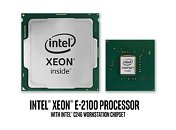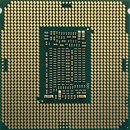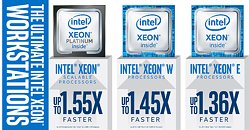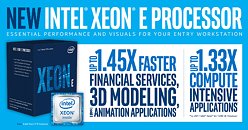Thursday, July 12th 2018

Intel Announces New Generation Xeon E Processor Family
Intel today announced the release of the new Intel Xeon E-2100 processor. The Intel Xeon E processor, successor to the Intel Xeon E3 processor, is designed for entry-level workstations that provide creators with powerful, single-threaded application performance with a platform optimized for reliability and affordability.
"With today's workloads, aging workstations impede productivity, collaboration and creativity. The release of the Intel Xeon E processor is intended to deliver the essential performance and visuals for entry workstations, as well as optimizing the innovative form factors, designs and diverse requirements of our customers," said Jennifer Huffstetler, vice president and general manager, data center product management, Intel Corporation.The new Intel Xeon E processor delivers a powerful combination of performance and capabilities for entry-level workstations. They are architected and crafted for the demands of creative professionals. Compared with its predecessor, the new processor offers higher max turbo frequency, faster DRAM speeds, enhanced I/O, and advanced security and reliability features. These processors are available with Intel UHD graphics supported by a broad set of workstation application.
The Intel Xeon E-2100 processor is a 6-core processor targeted at entry-level workstations. The combination of two additional cores and higher single-core turbo frequency delivers increases in performance across workstation benchmarks as compared with previous 4-core entry workstation processors. The processor offers Error Correcting Code (ECC) memory, a key feature to maximize data integrity, to help improve system stability and to reduce the possibility of silent data corruption.
Workstations powered by Intel Xeon processors meet the highly diversified demands of creative professionals in fields such as architecture, engineering, media and entertainment, and financial services. The Intel Xeon E processor is the latest addition to Intel's portfolio of workstation-optimized processors, which also includes Intel Xeon Scalable processors (delivering breakthrough dual-socket performance for the most advanced workstation professionals), and Intel Xeon W processors (targeting mainstream workstations with a combination of performance, enhanced memory capabilities, and hardware-enhanced security and reliability features).
Features:
"With today's workloads, aging workstations impede productivity, collaboration and creativity. The release of the Intel Xeon E processor is intended to deliver the essential performance and visuals for entry workstations, as well as optimizing the innovative form factors, designs and diverse requirements of our customers," said Jennifer Huffstetler, vice president and general manager, data center product management, Intel Corporation.The new Intel Xeon E processor delivers a powerful combination of performance and capabilities for entry-level workstations. They are architected and crafted for the demands of creative professionals. Compared with its predecessor, the new processor offers higher max turbo frequency, faster DRAM speeds, enhanced I/O, and advanced security and reliability features. These processors are available with Intel UHD graphics supported by a broad set of workstation application.
The Intel Xeon E-2100 processor is a 6-core processor targeted at entry-level workstations. The combination of two additional cores and higher single-core turbo frequency delivers increases in performance across workstation benchmarks as compared with previous 4-core entry workstation processors. The processor offers Error Correcting Code (ECC) memory, a key feature to maximize data integrity, to help improve system stability and to reduce the possibility of silent data corruption.
Workstations powered by Intel Xeon processors meet the highly diversified demands of creative professionals in fields such as architecture, engineering, media and entertainment, and financial services. The Intel Xeon E processor is the latest addition to Intel's portfolio of workstation-optimized processors, which also includes Intel Xeon Scalable processors (delivering breakthrough dual-socket performance for the most advanced workstation professionals), and Intel Xeon W processors (targeting mainstream workstations with a combination of performance, enhanced memory capabilities, and hardware-enhanced security and reliability features).
Features:
- Up to 6 cores and 12 threads
- Up to 4.70 GHz using Intel Turbo Boost Technology 2.0
- Up to 64 GB DDR4 ECC 2666 MHz
- Available with Intel UHD Graphics 630 supporting 4K UHD with built-in HEVC 10-bit hardware acceleration delivers enhanced 4K media decoding and encoding
- Up to 40 lanes of PCIe for graphics, storage and network expandability
- Support for USB 3.1 and Thunderbolt technology
- Support for Intel Optane memory for a faster, smoother and amazingly responsive computing experience
- Advanced hardware-enhanced security with Intel vPro technology and enhanced Intel Software Guard Extensions Support for Intel Ethernet and Intel Wireless-AC networking




34 Comments on Intel Announces New Generation Xeon E Processor Family
For servers it's okay, but I'm buying i7 since long ago for workstations. And if Dell would sell AMD cpus, I would be f*cking happy.
With that said, when I think of the E3 lineup, I never think of workstation. These processors are little beasts. Of course, I always buy the higher frequencies of >3.6GHz.
And why can't/wouldn't people simply use desktop-class CPU with six cores instead?
Don't memory errors basically result in BSODs anyway?
This is a pretty good explanation of ECC although he also covers the ZFS filesystem. Ya might want to grab some coffee or an energy drink to read the whole thing =]
In a small business it'd be maybe some ryzen embedded, threadripper or ofc xeon who all have official support for such application and thus are priced higher than a consumer ryzen which also supports it all unofficially as it's up to motherboard vendor.
But with consumer parts you usually can't go screaming to the vendor that it doesn't work as a server :)
For a normal user, those are irrelevaant tbh...
May be good for some server applications but clearly there's better to be had for less than these would go for. Also since it's a Xeon the price will be high too, doesn't make much sense at all for standard desktop use either.
Can't say they aren't trying but I see this hitting said wall and sliding down..... Like a pickle slung on a window.
We've all done that somewhere before......:laugh:
The quad core HT variants of these might become very interesting alternatives next to the 4c4t i3s and 6c6t i5s
The "up to 40 PCIe lanes" is a new, sleazy Intel marketing strategy of combining the CPU and chipset lanes to make it look like the platform is far better than it is. I would love to see AMD hit back at this with a Ryzen marketing campaign, something along the lines of "our consumer CPUs support ECC, why can't yours Intel?" and/or "real CPUs have 24 real PCIe lanes".There are a lot of claims floating around that Ryzen doesn't have "true" ECC, it just supports ECC memory. And even though the Ryzen CPU does, it's up to the motherboard vendors whether they want to support ECC on their boards - many do not. Finally, the Ryzen APUs do not support ECC, which means if you are building a home server you need a discrete GPU, which means you need a board with at least 2 PCIe slots if you want/need to run something like a RAID card, which rules out an mITX storage build.What exactly makes these chips more compelling than the Core line? 100MHz extra boost clocks?